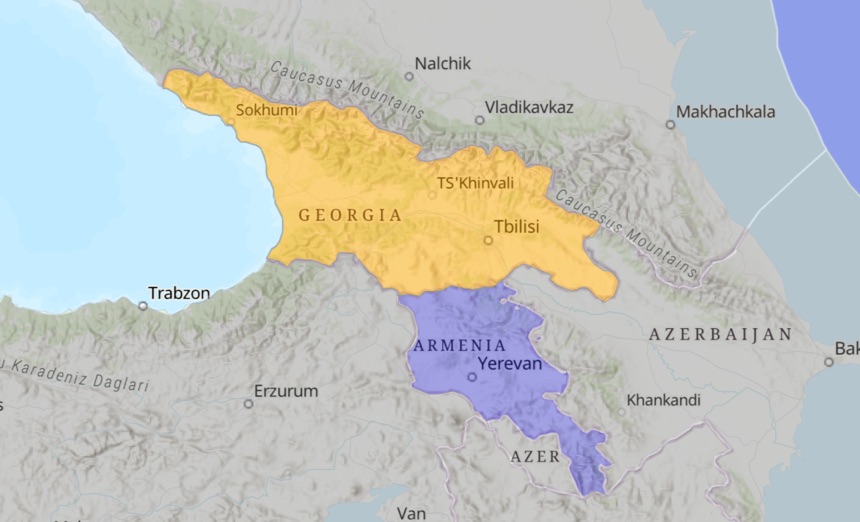Since the armed conflict with Russia in 2008, the security situation in Georgia has been relatively stable.1 Nevertheless, Russia continues to occupy the Georgian territories of Abkhazia and South Ossetia and, as of 2023, reports state that law enforcement violations persist in the country.2 Georgia has low levels of weapons and ammunition trafficking.3 Due to the 2008 conflict and lack of access to certain areas, landmines and unexploded ordnance remain in the country (although the exact extent is unknown).4
The Organization for Security and Co-operation in Europe (OSCE), the United States European Command, the Golden West Humanitarian Foundation, the HALO Trust, and ITF Enhancing Human Security are working on the ground to support the through-life management of ammunition, in collaboration with the Georgian Ministry of Defence. Efforts have included organising physical security and stockpile management training and site assessments, providing technical advisory support for the development of national ammunition regulations and supporting explosive ordnance clearance.5
1 Bertelsmann Stiftung, BTI 2022 Country Report: Georgia (Gütersloh: Bertelsmann Stiftung, 2022), https://bti-project.org/en/reports/country-report/GEO.
2 "Georgia," Rule of Law in Armed Conflicts Project (RULAC), Geneva Academy of International Humanitarian Law and Human Rights, updated September 6, 2017, https://www.rulac.org/browse/countries/georgia#collapse1accord; “World Report 2023: Georgia Events of 2022,” Human Rights Watch, accessed September 11, 2023, https://www.hrw.org/world-report/2023/country-chapters/georgia.
3 Philip Alpers, Irene Pavesi and Michael Picard, Georgia – Gun Facts, Figures and the Law (GunPolicy.org, Sydney School of Public Health, University of Sydney, 2022), https://www.gunpolicy.org/firearms/region/georgia.
4 “Georgia,” HALO Trust, accessed July 14, 2022, https://www.halotrust.org/where-we-work/europe-and-caucasus/georgia/; “Georgia,” Landmine & Cluster Munition Monitor, accessed July 14, 2022, http://www.the-monitor.org/en-gb/reports/2020/georgia/mine-action.aspx.
5 “Ammunition Management Activity Platform (A-MAP),” GICHD, 2022, https://a-map.gichd.org.
Launch the country dashboard
Further information
Accidental explosions
Since the Small Arms Survey began collecting data in 1979, four accidental explosions have been reported in Georgia.
Table 1. Accidental explosions in Georgia (1979–2021)
Year | Location | Owner/manager | Deaths | Injuries |
2017 | Primorskoye | Non-state (actor) | 2 | 64 |
2009 | Akhalgori | Foreign (intervention) | N/A | N/A |
2008 | Tskhinvali | Foreign (intervention) | N/A | N/A |
1996 | Osiauri | State (military) | N/A | N/A |
Source: “Unplanned Explosions at Munitions Sites (UEMS) Database,” Small Arms Survey, updated December 15, 2021, https://smallarmssurvey.org/database/unplanned-explosions-munitions-sites-uems.
Cases of diversion
Several cases of diversion have been reported since 2005 in Georgia.
Table 2. Cases of diversion of arms, ammunition and explosives in Georgia since 2005
Year | Location | Description |
2006 | N/A | According to sources, approximately seven thefts occurred from military barracks (involving a few dozen guns and less than ten grenade launchers) between 1996 and 2006. |
2005 | Vaziani | Battle-tank machine guns were stolen from a military base. |
Source: “Mod Declines Comment on Reported Robbery at Tank Repair Factory,” Civil.Ge, October 26, 2005, https://old.civil.ge/eng/article.php?id=11048; David Wood, Taking Stock: Small Arms and Human Security in Georgia (London: Caucasus Institute for Peace, Democracy and Development and Saferworld, 2006), https://www.files.ethz.ch/isn/32359/Taking%20Stock%20Small%20Arms.pdf.
Disposal
Insufficient information on the disposal of ammunition in Georgia.
Needs
To further enhance safe and secure ammunition management, the following need has been identified for Georgia:
- Development or refinement of standards and procedures on stockpile management (including legal assistance to develop new legislation in accordance with EU standards).
Source: Georgia, National Report on the Implementation of the Programme of Action on Small Arms and Light Weapons (PoA) and the International Tracing Instrument (ITI) (New York: Permanent Mission of Georgia to the UN, 2018), https://unoda-poa.s3.amazonaws.com/reports/GEO-English-71-SUBMITTED.pdf.



